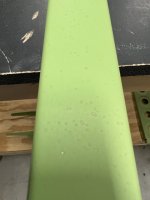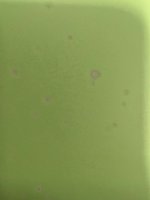Can someone help me understand my problem? (See pic)
I assume this is caused by either contamination on the surface or moisture in the air line.
I cleaned with Prekote and maroon scotchbrite, rinsed well, dried with compressed air, let sit for 12 hrs to fully dry, then primed, so I don't think it was contaminated. And I wore latex gloves the entire time.
I have a small water separator in the airline after 50' of hose. It's a 25gal compressor. I added another disposable water filter from harbor freight at the gun and the finish only improved marginally.
Could temperature do this? It was right at 60 degrees when I painted but it had been warming over several hours from a low of about 48. Otherwise, a beautiful day and I sprayed just outside my garage door.
This is AKZO primer mixed 50/50 and it sat for 30min after mixing before spraying. I'm using a 3M Accuspray gun with a 1.8 tip.
Any thoughts would be appreciated.
I assume this is caused by either contamination on the surface or moisture in the air line.
I cleaned with Prekote and maroon scotchbrite, rinsed well, dried with compressed air, let sit for 12 hrs to fully dry, then primed, so I don't think it was contaminated. And I wore latex gloves the entire time.
I have a small water separator in the airline after 50' of hose. It's a 25gal compressor. I added another disposable water filter from harbor freight at the gun and the finish only improved marginally.
Could temperature do this? It was right at 60 degrees when I painted but it had been warming over several hours from a low of about 48. Otherwise, a beautiful day and I sprayed just outside my garage door.
This is AKZO primer mixed 50/50 and it sat for 30min after mixing before spraying. I'm using a 3M Accuspray gun with a 1.8 tip.
Any thoughts would be appreciated.






